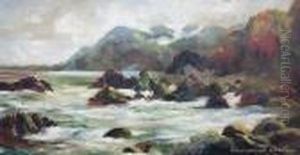Alfred Henry O Keeffe Paintings
Alfred Henry O'Keeffe, also known as A. H. O'Keeffe, was a New Zealand artist, born on October 18, 1858, in Auckland. He was among the notable figures in the country's art scene during the late 19th and early 20th centuries. O'Keeffe's early life and artistic development were shaped by the colonial environment of New Zealand, where he was exposed to the diverse cultural and natural landscapes that would later influence his work.
O'Keeffe demonstrated artistic talent from a young age and sought to refine his skills through formal education. He attended the Imperial School of Art in Rome, which was a significant move that exposed him to classical art and the European masters. This education laid the foundation for his artistic style, which incorporated elements of realism and impressionism. Upon returning to New Zealand, O'Keeffe became an influential figure in local art circles, contributing to the development of fine arts in the country.
Throughout his career, O'Keeffe was known for his landscape paintings, which captured the unique light and scenery of New Zealand. He was adept at portraying the country's rugged coastlines, tranquil bush scenes, and pastoral landscapes. O'Keeffe's works were characterized by a keen observation of nature and a distinctive use of color and light, revealing the influence of his European training while also expressing a deep connection to his homeland.
In addition to his painting, O'Keeffe was an art educator, passionately sharing his knowledge and skills with a new generation of New Zealand artists. He taught at various institutions and played a crucial role in fostering the arts in the region. His dedication to art education helped to establish a vibrant artistic community in New Zealand.
Alfred Henry O'Keeffe's legacy is preserved in the collections of several New Zealand art galleries and museums, where his works continue to be appreciated for their contribution to the nation's artistic heritage. He passed away on July 10, 1941, leaving behind a body of work that remains an important part of New Zealand's cultural history.
